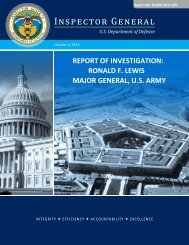Command Red Team
2gWzzvB
2gWzzvB
Create successful ePaper yourself
Turn your PDF publications into a flip-book with our unique Google optimized e-Paper software.
<strong>Command</strong> <strong>Red</strong> <strong>Team</strong> Organization<br />
issues. During mission execution, the team should also be represented on or within<br />
appropriate boards, centers, cells, or working groups.<br />
e. Performance Standards. Many aspects of red teaming do not readily lend<br />
themselves to simple quantification. The output of a well-integrated team may be<br />
seamlessly incorporated into the staff’s final product or published as a stand-alone<br />
product; however, the results may not be readily quantifiable. The red team’s ultimate<br />
measures of success are not the number of independent products published, or whether its<br />
assessments are accurate, or whether its suggestions are adopted, or whether its projected<br />
wildcards or unintended consequences actually occur. The team should instead be rated<br />
on the quality of its reasoning, the depth and scope of its insight, the professionalism of<br />
its products and staff interactions, and the quality and scale of its actual, though often<br />
intangible, contributions to the staff’s work.<br />
4. <strong>Command</strong> <strong>Red</strong> <strong>Team</strong> Membership Considerations<br />
a. Selection Criteria. Unique life experiences, unconventional educations, and<br />
distinct personality traits can often contribute to the development of a keen strategist, an<br />
insightful analyst, or a thoughtful advisor. <strong>Red</strong> team member selection should likewise<br />
consider factors beyond traditional career development paths, professional military<br />
education, and technical training. Regardless of natural talents, red team members should<br />
receive formal red team training.<br />
b. Diversity. A team composed of members drawn from different functional areas<br />
or analytic backgrounds is more likely to frame problems using a wider range of<br />
alternative perspectives, to recognize a more varied set of weak assumptions, and to see a<br />
more complex mix of threats and opportunities. In addition, teams drawn from a variety<br />
of career fields and experiences tend to have more credibility across the staff and may be<br />
able to provide meaningful support more quickly than a team with less varied<br />
backgrounds. A team drawn solely from a single functional area can, over time, come to<br />
be seen as a competitor by members of that functional area or only relevant to that<br />
functional area.<br />
c. Turnover. The periodic influx of new talent can enhance the team’s credibility<br />
and promote new thinking. New team members can also help avoid a stagnating team<br />
that unknowingly begins to perpetuate its own hidden assumptions and biases or that<br />
unconsciously begins to conform to the staff’s positions. In addition, the stress of<br />
constantly advocating unorthodox positions and combating organizational influences can<br />
over time cause some individuals to censor themselves, avoid engagement, or lose<br />
morale.<br />
5. <strong>Command</strong> <strong>Red</strong> <strong>Team</strong> Leader<br />
a. Responsibilities. Next to the commander and COS, the red team leader has the<br />
greatest impact on the ability of the team to support the staff. The team leader represents<br />
the team to the commander and the staff, and the team’s success will depend on the<br />
II-7



